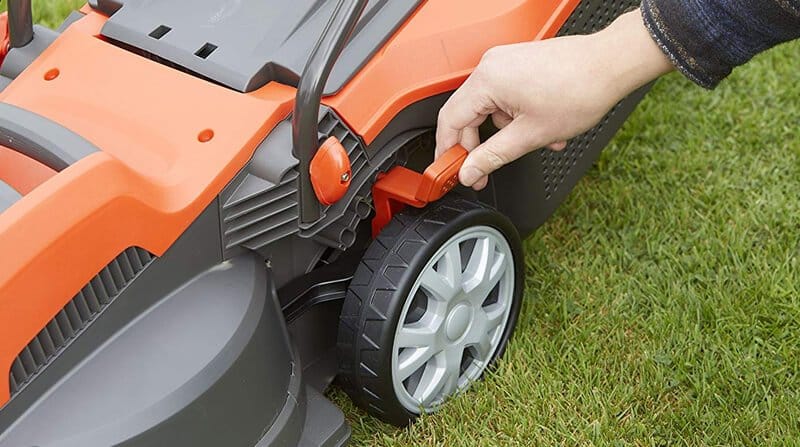One of the biggest mistakes gardeners make when cutting the grass is to mow too low.
This can cause a knock-on effect which leads to all kinds of problems including weed infestations, moss takeovers and the spread of disease.
So then, exactly how high should you cut grass in order to avoid these problems and keep your lawn lush and healthy?
The Ideal Mowing Height

The ideal mowing height for your grass is a compromise between;
- How high you think your lawn looks its best, and
- Keep enough leaf for grass to stay healthy
How High You Like the Grass
At what length you do like your grass cut? Have you ever even thought about it?
People who like a striped finish may keep a bit of length. This is because it makes the striped effect much bolder than if the grass is cut short.
On the other hand, if you like a bowling green finish then you’ll want to mow closely using the best lawn mower you can afford.
If you like a closer cut, that’s fine. However, you should only mow closely when growing conditions are at their best. That means rain, sun, warmth and adequate lawn feed. You’ll also want to mow at the best time of day.
Spring and autumn provide the best conditions for growth.
If any of these conditions change to drought, constant rain or feezing, you’ll need to increase the mowing height in order to for the grass to survive.
Keep Enough Leaf For Grass to Stay Healthy
If your lawn is formal or ornamental then chances are, you won’t have kids and pets tumbling about on it.
In which case, the grass can cope better with closer mowing as won’t have to deal with the stress of heavy use.
However, if you and your family use your lawn as a play area or for entertaining, you’ll want to keep the grass a little longer.
Not only will this create a softer surface, but it also keeps length on the leaf so the grass can trap enough sun to photosynthesize and repair itself from the stresses of heavy use.
The ‘Rule of Thirds’

The term, ‘rule of thirds’ is borrowed from photography and is one of the rules of composition.
When cutting the grass, however, it means you should never cut away more than a third of the leaf. Especially when mowing long grass.
Stick to this rule and you’ll never cut too short.
For example…
If your grass is currently 9cm high, you’d want to remove a maximum of 3cm. Any more and you’ll remove too much of the leaf.
When you remove too much leaf, you not only rob the grass of its stored food supply, but you also reduce its ability to produce more food through photosynthesis.
This stunts root development and as a result, you end up with a weaker lawn with patchy grass.
So with that said, how you do cut tall grass short without causing problems?
How to Reduce the Height of Your Lawn Using the Rule of Thirds
Let’s say it’s spring and conditions for grass growth are good. Your grass is currently 12cm high and you want to get it down to your preferred height of 4cm.
In order to reduce the height in a way that doesn’t affect the health of the grass, you need to do it gradually;
Step 1:
Cut the grass, removing no more than a third which is 4cm, bringing the height down to 8cm.
Then, let the grass recover a grow by 1cm so it’s now 9cm hight. The speed at which the grass grows will depend on the weather conditions.
Step 2:
Mow the lawn again, only removing a third of the leaf which is now 3cm. This reduces the height to 6cm.
Again, let the grass recover and grow by 1cm so it’s now 7cm tall.
Step 3:
Reduce the height by a third again which is roughly 2.5cm to reduce the height to 4.5cm.
Let it grow by 1cm again so it’s 5.5cm tall.
Step 4:
On this last cut, you’ll reduce the height by 1.5cm which is just less than a third and your grass will now be at your desired height.
As you can see, it only took 4 cuts to bring the grass down to your preferred length.
The speed at which the grass grows and therefore the time between cuts will depend on the weather conditions.
Maintaining Your Lawn at Your Preferred Height
Now you’ve got the grass down to your preferred height, you should never let the grass grow by more than a third.
So using the example above, to keep your lawn at 4cm tall you’ll not want to let the grass grow by 1.3cm.
The shorter you like the cut, the more often you’ll need to mow to maintain that length.
For example, if you have a formal lawn and the grass is only 10mm long, you’ll not want to let the grass grow by more than 3mm.
Regardless of the mowing height though, never leave it longer than 10 days between cuts.
Regular mowing encourages the grass to grow new leaves from the base of the plant. This makes the lawn denser and that means less room for weeds, weed grasses and moss to creep in.
How High to Mow the Lawn: A General Guide
If you’re unsure how high you should cut your grass then this guide might help.
However, please take these guidelines as just that, a guide.
How high you mow the lawn depends on factors we’ve already discussed.
But if you’re asking how high you should mow the lawn in your garden, here is my advice;
- Family or utility lawns which contain ryegrass and get used a lot: 1-2″ or 3-5cm.
- Low use lawns that do or don’t contain Rye Grass: 3/4″ to 1½” or 2-4cm.
- Ornamental lawns which consist of only the fines grasses: 3/8″-3/4″ or 1-2 cm.
- Shady areas: add 50% so if the rest of your lawn an inch tall, make the shady areas 1½ inches.
- Sloped areas: these dry faster than other parts of your lawn so make them 50% higher than the rest of your lawn.
- Mossy lawns: Make sure the grass is at least half an inch taller than the moss.
- In times of stress (drought, heat, cold or wet): mow high 50% higher.
- If in doubt: mow high.
In Conclusion
As you can see, the answer to the question ‘How high should you cut grass?’ changes depending on the time of year, the type of lawn you have and how you use it.
However, if you follow the rule of thirds and my general guide to mowing heights, you’ll never cut the grass too short and your lawn will be lush and healthy all year round.

